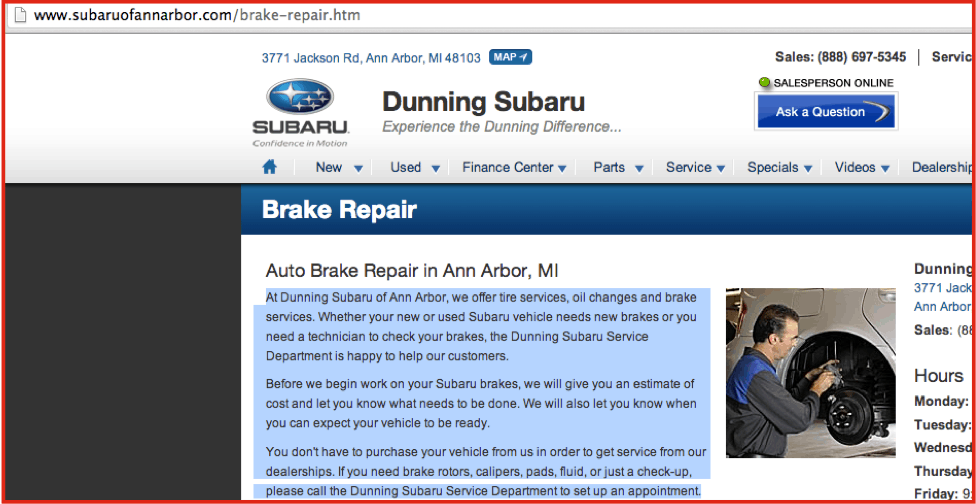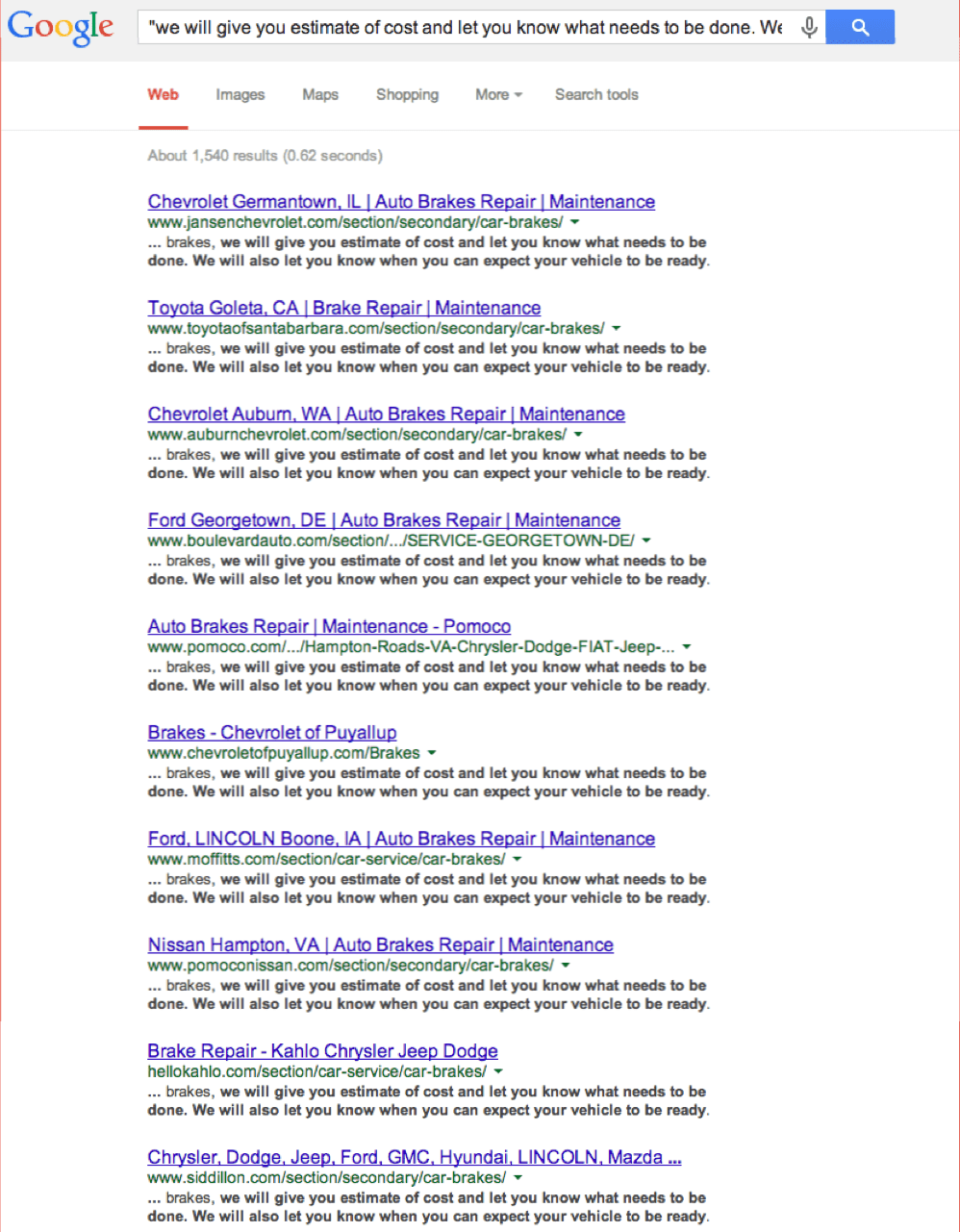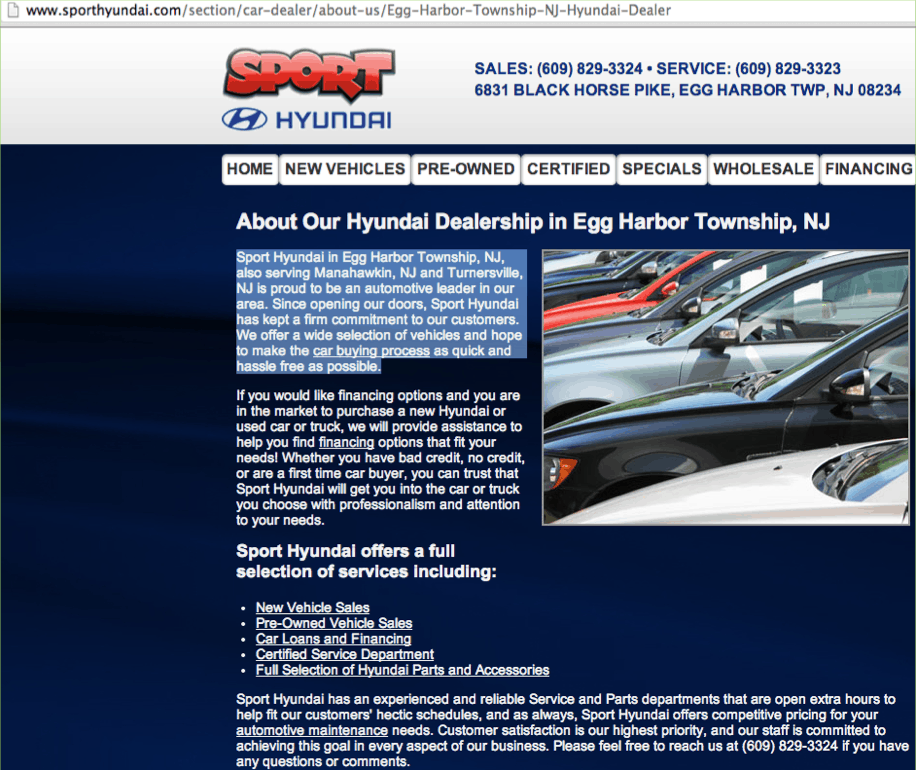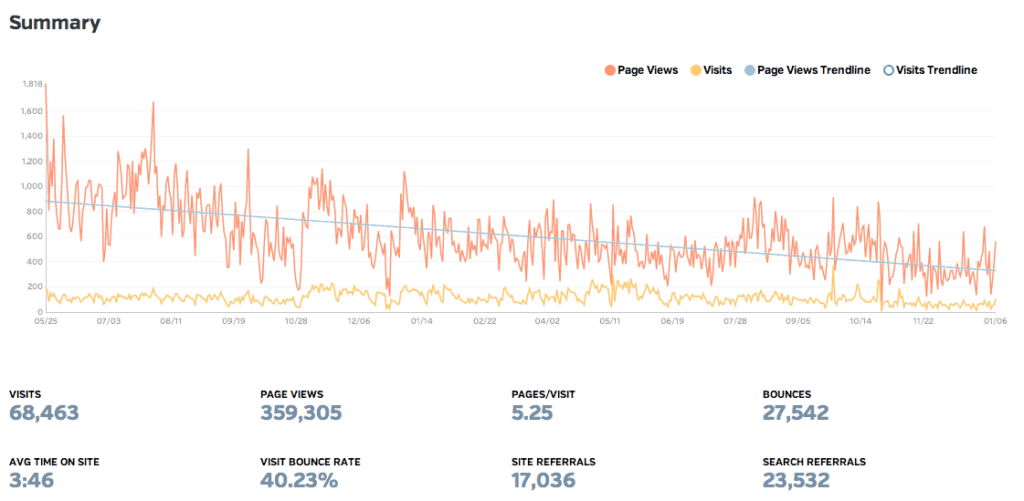I’m writing today because a serious fraud is being perpetrated on virtually all car dealers, the scope of which seems to be far greater than any I’ve encountered before. What seemed at first to be merely a bad SEO practice, now seems to amount to copyright infringement, a willful attempt to harm dealers while profiting from them, and perhaps even collusion by OEMs and vendors to control market performance between franchise owners. I’m not going to name names at this point. I have included screen shots and examples which would certainly allow someone to search and figure out for themselves who the culprits are and what, exactly, they are doing. This all began when two new clients sought our services due to severe drops in search performance. They are both clients of website vendor A. The larger dealer group had received a web spam penalty from Google while the smaller group experienced the following performance over the past year:
What could cause two thirds of this dealer’s client base to disappear in 7 months?
Google’s latest algorithm update? Negative SEO? A new dealer that caught SEO fire? What we found is much, much worse. Duplicate content, like we’ve never seen before. Now, I know what you’re thinking. Wow, big deal. SEO crap. But this is much different.
What we’ve found is that many, many website vendors have engaged in a form of deception and fraud. What’s worse, I believe some have simultaneously left their dealer clients in violation of copyright infringement. Here is the proof:

Pictured above is a page on Dunning Subaru’s website about brake repair. This site is built by website vendor B. Below are the search results generated by searching for examples of this text. This search generated 1,540 results, and this was one of the smallest infractions we found. Upon closer inspection, we found that most of the websites listed here were built by website vendor A, but Jansen Chevrolet and Chevrolet of Puyallup were built by website vendor C. Now, if you visit sites by each of these vendors you will notice something at the bottom of each page: Dunning Subaru, Jansen Chevrolet, and Toyota of Santa Barbara.

I suspect the answer is a lot of billable hours to a good law firm.

When I ran the search last week I found 1.9 million results.
Why is this so outrageous?
When the dealer enters into an agreement with a website vendor, there is an expectation of expertise. It’s the vendor’s job to be aware of practices or procedures that could harm their client and they should be dedicated to never harming their client.
In 2005, Google publicly announced that web masters who used duplicate content would see their websites penalized. While many SEOs would agree that this didn’t take place early on, there isn’t a (competent) web master on the planet that is unaware of the Panda update released by Google in February 2011.
“Google says it only takes a few pages of poor quality or duplicative content to hold down traffic on an otherwise solid site, and recommends such pages be removed, blocked from being indexed by the search engine, or rewritten.[11] However, Matt Cutts, head of webspam at Google, warns that rewriting duplicate content so that it is original may not be enough to recover from Panda — the rewrites must be of sufficiently high quality, as such content brings “additional value” to the web. Content that is general, non-specific, and not substantially different from what is already out there should not be expected to rank well: “Those other sites are not bringing additional value. While they’re not duplicates they bring nothing new to the table.”
“Only a few pages of poor quality or duplicative content.” As we continue to research this issue, we’re finding that virtually every page (we’re talking hundreds and even thousands of pages in some cases) on most dealer websites is duplicate content. To make matters worse, in most cases, the primary offenders of this content plagiarism are also selling “SEO services” in conjunction with their websites. In almost every case, we’ve found that not only do these website providers NOT provide any form of SEO service, most of the time they are actually charging the dealer for creating more duplicate content and copying it to all of their other clients’ websites! That means that they are actually doing more damage, faster, and charging a premium for it!
How can you tell if you are being plagued by duplicate content?
The easiest way to determine this is your “about” page. If you didn’t write your own content for your dealership about page, start there. Try selecting a large portion of text that doesn’t include your dealership name or geo information. Copy and paste what you copied into the google search bar and then put the text in quotation marks. Do you get a list of lots of other car dealers? Chances are yes, you do. If you’re not sure about how to do this, you can e-mail us at questions@wikimotive.com and we’ll be happy to walk you through it. And before you suspect that we have ulterior motives, we are not an automotive website vendor. We DO NOT have a dog in this fight other than looking out for dealers.
My content is all over the web! What can I do?
Remember, what Matt Cutts said, “Rewriting duplicate content so that it is original may not be enough to recover from Panda — the rewrites must be of sufficiently high quality, as such content brings ‘additional value’ to the web.”
In most cases, this means a real need to start from scratch.
BIG IMPORTANT POINT TO TAKE AWAY
If you are a client of one of the website vendors in the results here, there is no immediate fix short of finding a new provider, and unless you have the knowledge and expertise to understand what differentiates one provider from the next, there is a real likelihood that you will trade one bad vendor for another. So far, we’ve only found a single website vendor that is not building sites this way and does not use duplicate content on their websites. If any other vendors are out there listening and are digging what I’m saying and wondering why no one has ever called this out before, please give me a call. We’d love to find more great solutions for our car dealers.
My website rep/seo guy/gal etc says that the content is unique because my name is in there and there are different geo modifiers in the content and that makes it unique. What is he/she talking about?
They are L I A R S or they were trained to say that by LIARS. Google SPECIFICALLY looks for content that is the same with minor changes like proper nouns and geo modifiers. It’s the worst kind of duplicate content because it tries to be deceptively manipulative.
Well they said that Google allows for duplicate content for businesses because product information like inventory is all the same and can’t be unique. Is that true?
Not exactly. This allowance is for e-commerce platforms and is suspected to be applied to the inventory on dealer websites. BUT there’s a catch. The webmaster must include code on those duplicate pages that signals this to Google. Its called the rel=cannonical tag, and most of the website providers DON’T USE IT FOR INVENTORY! That means your inventory is duplicate content too!
I tried to include the regular spin you’ll likely hear if you research this, but understand, one of the website providers listed here recently sold for nearly $1 billion. These are massive companies who’s primary client is the OEM not you the dealer.
Why would my OEM want my website provider to hurt me?
Maybe it wasn’t originally intended, or by design, but I have to believe that the most digitally savvy people working for OEMs realize that by devaluing the authority of the dealer website it makes it easy for the OEM to rank in the dealer’s backyard which then gives the consumer choice. Remember, if you’re a Honda dealer the best place to increase your sales efficiency is by taking deals from the nearest Honda dealer you compete with. The OEM doesn’t want this because they still sell the same customer the same Honda. They want you to take deals from the Toyota dealer and the Nissan dealer. How can they ensure this happens? By controlling the level of competition in search.
We are still researching this issue and will continue to update the community on our findings. Our goal is to see these website vendors face the reality of the continually evolving digital landscape. You’ve known this was coming and if you haven’t prepared for it, shame on you.
Its time to do whats right and serve the dealer.

2 Comments
Comments are closed.